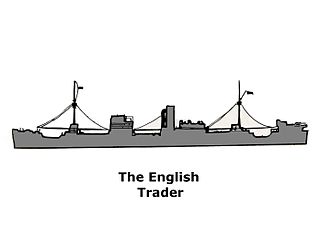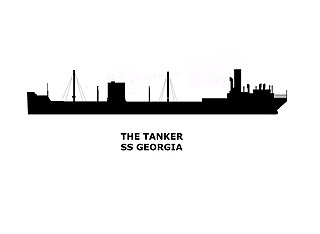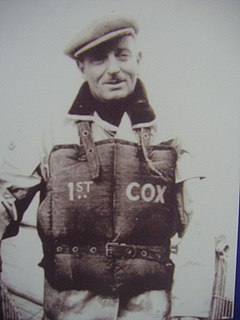
Henry George Blogg GC BEM was a lifeboatman from Cromer on the north coast of Norfolk, England, and the most decorated in Royal National Lifeboat Institution (RNLI) history.

Walmer Lifeboat Station was established in 1830. Over two thousand ships are believed to have been wrecked on the Goodwin Sands, and the masts of several wrecks are visible from the shore at low tide. Hence there have always been two lifeboats located at the joined towns of Deal and Walmer along the coast opposite the sands.

The SS English Trader was a British merchant ship wrecked off the coast of Norfolk, England in October 1941. After falling behind a convoy during the Second World War of which she was a part, the ship ran aground on the Hammond's Knoll sandbank and began to break up during a gale. Several rescue attempts by lifeboats failed, but a further attempt the following day by the Cromer Lifeboat rescued 44 of the crew, three having already been lost.

SS Georgia was an oil tanker lost at Haisborough Sands off the coast of Norfolk, England in November 1927.

Henry "Shrimp" Thomas Davies BEM was a lifeboatman from Cromer on the north coast of Norfolk, England. His uncle, Henry Blogg, gave him the nickname "Shrimp" after seeing him as a tiny baby. In 1931 he joined the crew of the Cromer lifeboat H F Bailey and became coxswain in 1947, taking over from Henry Blogg. Davies retired in February 1976, after serving as coxswain of lifeboats Henry Blogg and Ruby and Arthur Reed, having been one of Cromer Lifeboat Station's longest serving coxswains.

RNLB H F Bailey is the most famous Royal National Lifeboat Institution (RNLI) lifeboat to have served from Cromer, because she was used by Coxswain Henry Blogg to perform many of his most famous lifesaving exploits. The lifeboat was on station for the ten years between 1935 and 1945. She is now part of the National Historic Fleet and has been preserved in the RNLI Henry Blogg Museum in Cromer.

SS Cantabria was a Spanish cargo ship which was sunk in a military action of the Spanish Civil War, off the coast of Norfolk 12 miles ENE of Cromer on 2 November 1938. The ship was shelled by the Spanish Nationalist auxiliary cruiser Nadir, which was part of General Franco's navy.

RNLB Henry Blogg was the eighteenth lifeboat to be stationed at Cromer in the county of Norfolk.

RNLB Louisa Heartwell was the sixth lifeboat to be stationed at Cromer on the coast of the English county of Norfolk She was launched from the beach station and was on station from 1902 to 1932. During her period on station at Cromer the Louisa Heartwell had only two coxswains during her 29-year career. They were Matthew James Buttons Harrison until his retirement in 1909, and then Henry George Blogg.

SS Monte Nevoso was a cargo steamship that was launched in 1920 in England, owned in Italy, and wrecked in 1932 in the North Sea off the coast of Norfolk.
The SB Hibernia was a 75-ton spritsail Thames barge built in Greenhithe, Kent in England in 1906, and which was wrecked on the North Sea coast at East Runton during the night of 9/10 November 1937. Her crew of three were rescued by the Cromer lifeboat.

SS Meriones was a Blue Funnel Line refrigerated cargo steamship. She was launched in 1921 on the River Tyne as one of a class of 11 ships to replace many of Blue Funnel's losses in the First World War.
SS Gallois was one of seven merchant vessels which became stranded and then wrecked on Haisbro Sands of the Norfolk coast on 6 August 1941 during the Second World War. The SS Gallois had been part of a convoy with the designation Convoy FS 559.

Alf was a three-masted Norwegian barque which became stranded and then wrecked on 23 November 1909 on Haisbro Sands, off the coast of Norfolk. She was originally built in 1876 as Inchgreen for Scottish owners. In the 1890s she was sold to Danish owners and renamed Adolph Harboe. Around the turn of the 20th century she was sold to Norwegian owners and renamed Alf, serving until she was wrecked off the coast of Norfolk.

William George Fleming GC (1865–1954) was a lifeboatman from Gorleston on the east coast of Norfolk, England. His service with the Royal National Lifeboat Institution (RNLI) spanned nearly fifty years, in which time he won the George Cross and the RNLI Medal in Gold and in Silver, and the Bronze Medal three times.
SS Hopelyn was a Merchant vessel from Newcastle which became stranded and then wrecked on Scroby Sands of the Norfolk coast on 17 October 1922.

HM Trawler Agate was purchased by the Royal Navy in 1935. She was modified from a trawler to be used to carry out anti-submarine work. In 1941 she was with the maintenance reserve at Rosyth, but in August was part of the Royal Navy's escort flotilla with convoy FS559 when she ran aground, becoming a total loss, on Haisborough Sands on 6 August with a loss of sixteen crewmen.

RNLB Foresters Centenary is a retired Liverpool-class lifeboat of the Royal National Lifeboat Institution (RNLI), stationed in the English coastal town of Sheringham in the county of Norfolk in the United Kingdom. The lifeboat was on station for 25 years between 1936 and 1961 when she was sold. She has been restored to her original condition and is exhibited in Sheringham Museum.
RNLB H F Bailey II was the third lifeboat stationed at Cromer to bear this name, but the first of the four to bear a number in its name. This lifeboat was sent to replace H F Bailey. Coxswain Henry Blogg of the Cromer is often referred to as "the greatest of the lifeboatmen" was said to have disliked this lifeboat having preferred the previous lifeboat H F Bailey ON 695.
Convoy FS 559 was a British convoy in World War II. On the night of 5 August 1941, six merchant ships from the convoy ran aground on the Haisborough Sands. The Cromer lifeboat H.F. Bailey was the first to arrive, and rescued 16 men from the SS Oxshott of London, 31 from the SS Gallois of Rouen, 19 from the SS Deerwood of London and 22 from the SS Betty Hindley. The Cromer second lifeboat Harriot Dixon and the Great Yarmouth and Gorleston lifeboat Louise Stephens between them rescued a further 31 men.

















